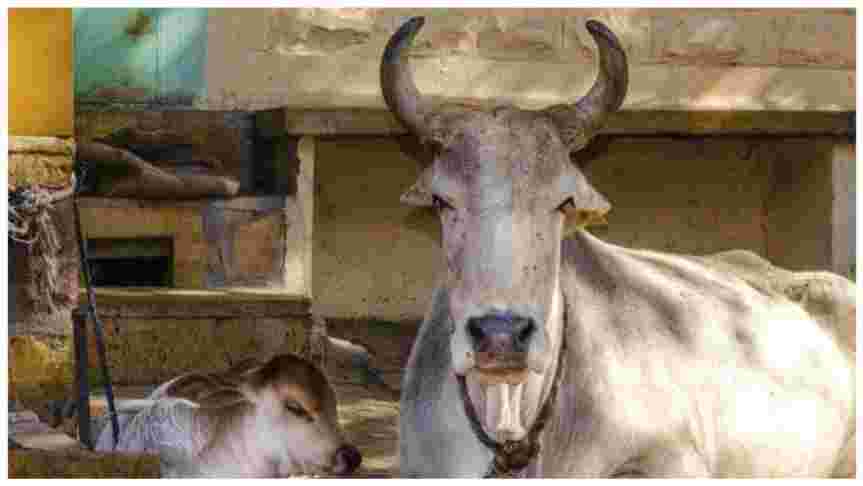
Introduction
There are several inconsistencies between non-Indian and Indian perspectives on vegetarianism. Cattle, especially cows, were neither inviolable nor adored in ancient times; according to D. N. Jha’s 2009 book The Myth of the Holy Cow, although he did not provide any evidence from the Vedas, Upanishads, or other Hindu texts. He was accused by Vedic experts of deliberately misinterpreting Sanskrit phrases. The Grihya Sutra proposes that mourners consume beef as a traditional process of passage following a funeral ceremony. The Vedic literature, according to Marvin Harris, is conflicting, with some proposing ceremonial slaughter and meat intake and others implying a meat-eating ban.
The preservation of animal life was championed by Jainism on the basis that aggression against life forms is a cause of sorrow in the cosmos, and that violence against any living being produces negative karma for a human being. The ethical principle of Ahimsa, or nonviolence toward all beings, is mentioned in the Chandogya Upanishad. By the middle of the first century BCE, all three main Indian faiths – Buddhism, Hinduism, and Jainism – had embraced nonviolence as a moral ideal and a factor in one’s reincarnation. By around 200 CE, feeding and feasting on animal slaughter were commonly regarded as a kind of aggression against living forms, according to Harris, and had become a theological and social taboo.
In 1580, Ralph Fitch, a gentleman trader from London and one of the first English travelers to India, wrote home, “They follow an odd order among themselves: they worship a cow and use a lot of the cow’s dung to decorate their homes… They don’t consume meat, instead subsisting on roots, grains, and milk.”
Since ancient times, the cow has been a symbol of prosperity in India.
Beef Ban According To Different Religious Texts
1. Hinduism:-
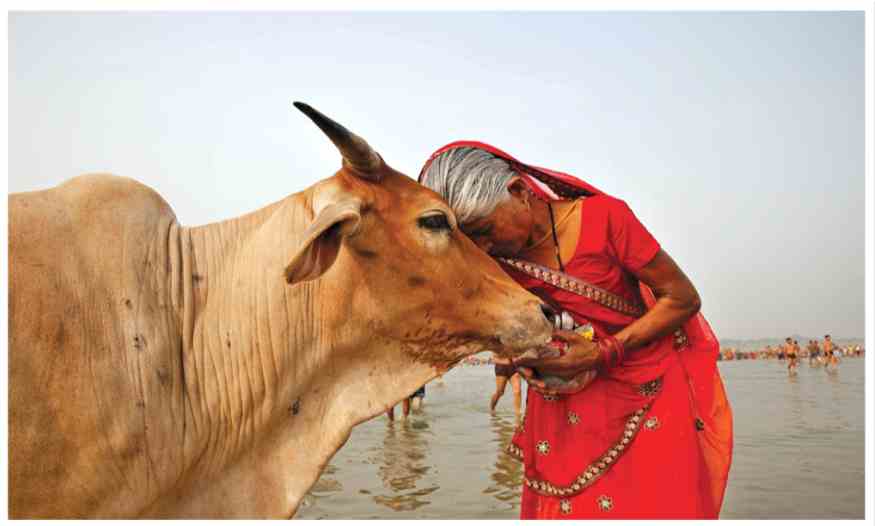
- Maharishi Dayanand Saraswati wrote a book called Gokarunanidhi in which he demonstrated the significance of cows not only spiritually, but also economically and environmentally. He underlined the significance of cow preservation and mentioned several Vedic shlokas that denounce cow killing.
Yajurveda:-
- Protect the cattle or animals. (Yajurveda 1.1)
- Kill neither man nor any being with life. (Yajurveda 3.91)
- Kill not the subjects. (Yajurveda 12.32)
- Oh, men! Protect or guard the cattle. (Yajurveda 6.11)
- Protect the bipeds and quadrupeds. (Yajurveda 14.8)
- Kill not the cows. (Yajurveda 13.43)
- Sagacious king! Don’t harm this bull, the giver of thousands of comforts, the source of immense milk and worthy of protection. Harm not the God’s creation, the cow, the giver of milk for mankind and of innocent nature. (Yajurveda 13.49)
- Beyond all measure is the cow (Griffith) i.e. there is no limit to the benefits she confers upon humanity.(Yajurveda 23.48)
- Kill not the animals, the bipeds (Griffith). (Yajurveda 13.47) Dayanand says in his commentary “Let no one kill animals that are useful to all but protect them and make use of them to make all happy. But the wild animals that injurious to the animals and to the cultivation of the villages and their inhabitants may be killed or driven away by the ruler.”
- Ruler! You have received an education; kill two-footed beings like men, neither birds nor four-footed beings like cows or other animals. In giving the object of the hymn Dayanand says ‘O ruler! You should punish those wicked people who kill sheep, camels, and other animals which are all useful to men.” (Yajurveda 13.50)
2. Jainism
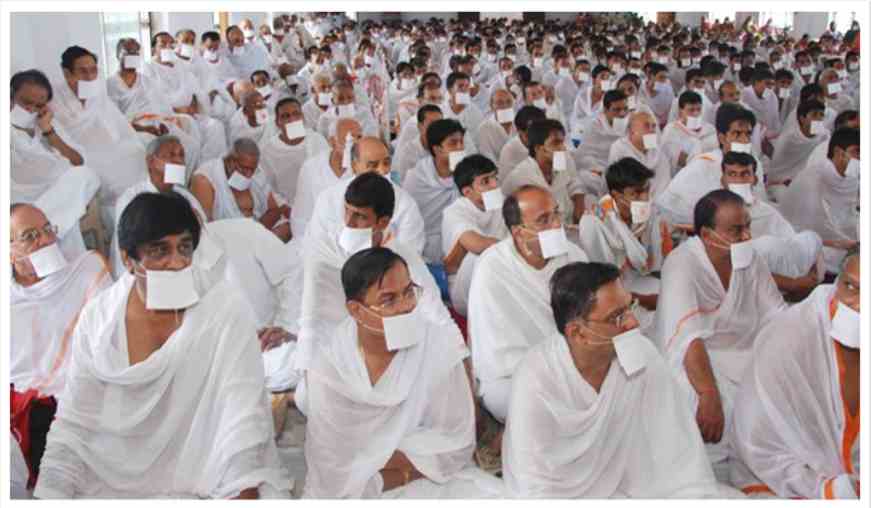
All living beings, including cattle, are considered sacred in Jainism. Humans must avoid all killing and murder, according to the Jaina sutras, since all living things are fond of life, suffer, feel pain, prefer to live and yearn to live. According to Jainism, all beings should aid one another to survive and thrive rather than kill and slay one another.
According to Jain tradition, neither monks nor laypeople should force or let anyone work in a slaughterhouse. Jains think that vegetarian forms of nourishment may give appropriate sustenance without harming animals like cattle.
According to some Jain scholars, slaughtering cattle increases the ecological burden of human food demands because meat production necessitates increased grain demands, and reducing cattle slaughter by 50% would free up enough land and ecological resources to eliminate all malnutrition and hunger globally. According to Christopher Chapple, the Jain community leaders have aggressively pushed to end all types of animal slaughter, including cattle slaughter.
Jains have spearheaded a historic movement to prohibit the killing of cows and other animals, notably during their annual Paryushana celebration (also called Daslakshana by the Digambara).
According to historical documents, Jain leaders persuaded Mughal kings to prohibit the killing of cattle and other animals during this 8 to 12-day period. They were granted their desire in certain situations, such as during Akbar’s dominion in the 16th century, and an edict was issued by Akbar. When the Jain community approached and petitioned Jahangir, he repealed the prohibition upon coronation, reinstalled it in 1610, and then reversed the 1610 ban with a fresh decree.
3. Buddhism
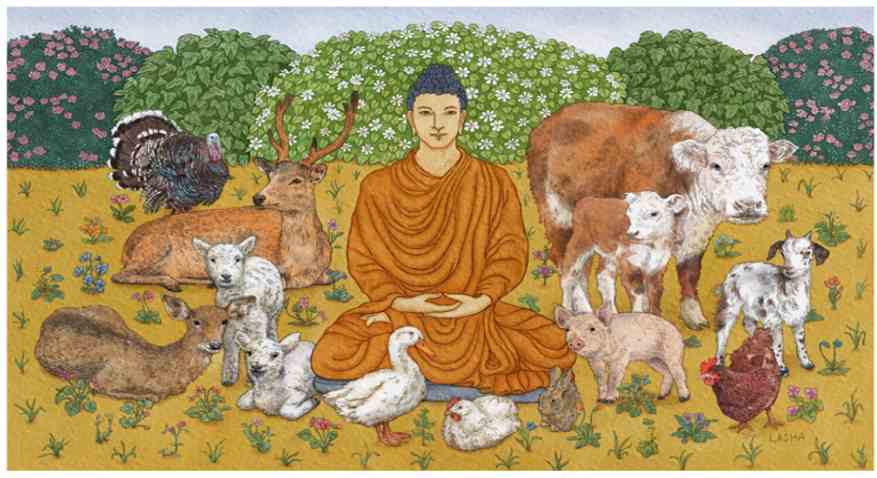
Ahimsa is one of five ethical precepts in Buddhism, and it demands a practicing Buddhist to “refrain from murdering living beings. “Cow slaughter has always been frowned upon, with some writings suggesting that caring for a cow is comparable to caring for “all living beings.” Protecting animal life and being friendly to cattle and other animals is good karma because cattle are considered reincarnated human beings in the unending rebirth cycles of samsara.
Buddhist writings say it’s improper to kill or eat meat, and they advise Buddhist laypeople not to work in slaughterhouses or deal in meat. Plant-based diets are encouraged in Indian Buddhist literature. In Buddhism, saving animals from slaughter for meat is seen to be a means of gaining merit for a better rebirth. There has been a disconnect between Buddhist precepts and practice, according to Richard Gombrich. According to Gombrich, vegetarianism is appreciated but rarely practiced. Nonetheless, according to Gombrich, there is a widespread belief among Theravada Buddhists that eating beef is worse than eating other meats and Buddhists owning cattle slaughterhouses is uncommon.
4. Sikhism

The cow, buffalo, and oxen, according to Arvind-Pal Singh Mandair, are an important element of rural Sikh lives, and they are never slaughtered for human use, are treated with respect, and beef is carefully avoided. Sikhs who have been baptized with the Amrit have always been devout vegetarians, avoiding all eggs and meat, even calf flesh. The broad question of vegetarianism vs non-vegetarianism is problematic within Sikhism, according to Eleanor Nesbitt, and current Sikhs differ. Uninitiated Sikhs are also not meat eaters by choice, and beef (cow flesh) has long been considered prohibited. Throughout his realms, Ranjit Singh, the founder of the Sikh Empire and Maharaja from 1801 to 1839, prohibited cow slaughter.
5. Islam

Islamic dietary patterns reached India with the introduction of Islamic control as the Delhi Sultanate in the 12th century. God created animals to benefit man, according to Quran passages like 16:5–8 and 23:21–23, and Muslims are encouraged to consume cattle flesh, while pork is forbidden. Cattle killing had been and remained to be a religiously sanctioned practice among Muslim rulers and adherents, notably on religious holidays like the Bakri-Id.
The cow slaughter taboo is mentioned in the earliest literature on the invasion of the Indian subcontinent, as well as its usage by Muslim army leaders as a political statement by violating the prohibition within temples. For example, the account of Muhammad bin Qasim’s conquest of Multan in the eighth century is referenced in Al-early Biruni’s 11th-century chronicle. “Qasim first asserts the superiority of Islam over the polytheists by committing a taboo (killing a cow) and publicly soiling the idol (giving the cow meat as an offering)” before allowing the temple to continue as a place of worship, according to Manan Ahmed Asif, a historian of Islam in South and Southeast Asia. Cow slaughter was taboo in India, as well as cow slaughter as a means of political message, and desecration, and prohibited by Sultans and Muslim Emperors as a means of accommodating public sentiments in the Indian subcontinent, according to court historians of the Delhi Sultanate, and later the Mughal Empire.
In 1756–57, the founder of the Durrani Empire, Ahmad Shh Durrn, attacked Delhi and devastated Agra, Mathura, and Vrindavan in what was his fourth invasion of India. He stormed the Golden Temple at Amritsar on his way back to Afghanistan, filling its hallowed pool with the blood of slain cows.
While most Muslims believe cattle to be a source of religiously acceptable meat, vegetarianism was embraced by several Muslim Sufi communities in India, at least during prayer and fasting seasons. According to Richard Foltz, their motivations were the same as those of other non-Muslim Indians, namely, concern for life and animals. This Sufi ritual was most likely influenced by Hindus or Buddhists from South Asia, according to Foltz.
British Rule
When the British took control of India, eating beef and drinking whiskey in English-language institutions in Bengal became a way of assimilating into the British culture. According to Metcalf and Metcalf, some Hindus drank beef in the 1830s to demonstrate how they “derided illogical Hindu practices.” The Indian Rebellion of 1857 against the British East India Company was fueled by veneration for the cow. Hindu and Muslim sepoys of the East India Company’s army came to think that the cow and pig fat lubricated their paper cartridges, which carried a precise quantity of gunpowder. Swine intake is prohibited in Islam. They believed that the British were compelling them to disobey religious edicts since loading the pistol involved chewing off the end of the paper cartridge. The slaughter of a cow was deemed a death offence during Bahadur Shah Zafar’s short reign as emperor.
According to historians, the cow was utilized as a symbol to mobilize Hindus. The Kuka Revolution began in 1870 when the Namdhari Sikhs revolted against the British and sought to safeguard the cows from slaughter. Swami Dayananda Saraswati, a few years later, urged the British to cease slaughtering cows and proposed the creation of Go-samvardhaniSabhas. Cow preservation campaigns swept Punjab, the North-West Frontier Province, Oudh State (now Awadh), and Rohilkhand in the 1870s. The Arya Samaj played a crucial role in turning this sentiment into a national movement.
Cow protection sentiment reached its peak in 1893. Large public meetings were held in Nagpur, Haridwar, and Benares to denounce beef-eaters. Riots broke out between Hindus and Muslims in Mau in the Azamgarh district; it took 3 days for the government to regain control. Cow slaughter was opposed by some prominent leaders of the independence movement. Mahatma Gandhi, Bal Gangadhar Tilak, Lala Lajpat Rai, Madan Mohan Malviya, Rajendra Prasad, and Purushottam Das Tandon supported a ban on cattle slaughter. In 1944, the British placed restrictions on cattle slaughter in India. During the British Raj, there were several cases of communal riots caused by the slaughter of cows. Some Muslim Sufi sects of India practiced vegetarianism during periods of prayer and fasting. The number of cattle slaughtered increased dramatically in the years preceding Independence.
Post-Independence
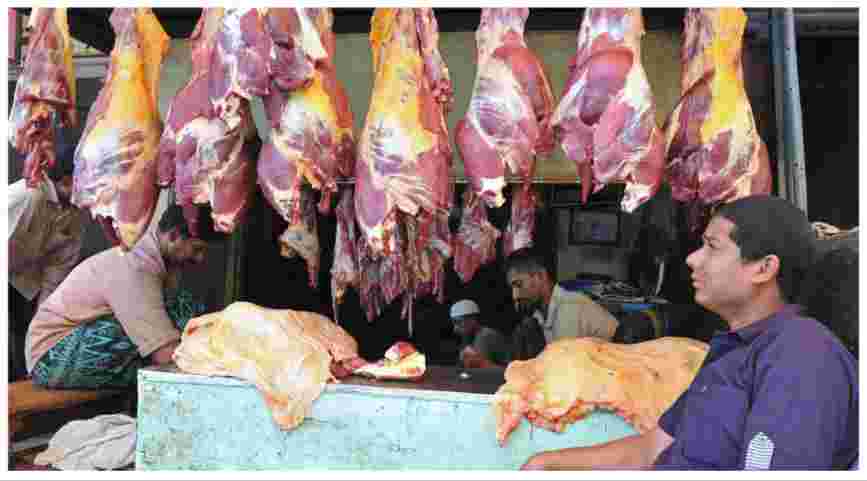
- India’s first Prime Minister Jawaharlal Nehru opposed this national ban on cow slaughter and threatened to resign if the elected representatives passed the bill in India’s parliament. State legislatures such as those of Uttar Pradesh, Bihar, Rajasthan, and Madhya Pradesh enacted their own laws in the 1950s. In 1958, a lawsuit was instigated in the Supreme Court of India regarding the constitutionality of slaughter ban laws in the state of Jharkhand. The Court determined that neither the Quran nor the Hidaya mandates cow slaughter, and Islamic texts allow a goat or camel to be sacrificed instead.
Legislations

Entry 15 of the State List of the Seventh Schedule of the Constitution states that “the preservation, protection, and improvement of stock, as well as the prevention of animal diseases, veterinary training and practice,” implying that State Legislatures have sole authority to legislate the prevention of slaughter and the preservation of cattle. The ban of cow slaughter is also one of the Constitution’s Directive Principles of State Policy (Article 48). “The State must Endeavour to organize agriculture and animal husbandry on modern and scientific lines, and shall, in particular, take measures to preserve and improve breeds, and prohibit the slaughter of cows and calves, as well as other milch and draught animals,” it says.
In one form or another, several state governments and union territories (UTs) have implemented cattle preservation legislation. There is no law in Arunachal Pradesh, Kerala, Meghalaya, Mizoram, Nagaland, Tripura, Lakshadweep, and the Andaman & Nicobar Islands. All other states and territories have passed legislation prohibiting the killing of cows and their offspring. Kerala is a big beef consumer, however, there are no laws prohibiting the killing of cows and their offspring. As a result, cattle from the neighboring states of Tamil Nadu, Karnataka, and Andhra Pradesh are routinely smuggled into Kerala for slaughter. Several cow carriers have been attacked on suspicion of transporting animals for slaughter. At least ten Muslims were murdered in these incidents between May 2015 and May 2017.
Muslims in Bihar petitioned the Supreme Court of India in 1958, claiming that the ban on cow slaughter infringed on their religious freedom. Their suit was unanimously dismissed by the Court. The Supreme Court has held in several cases, including Mohd. Hanif Qureshi v. the State of Bihar (AIR 1959 SCR 629), Hashumatullah v. State of Madhya Pradesh, Abdul Hakim and others v. the State of Bihar (AIR 1961 SC 448), and Mohd. Faruk v. State of Madhya Pradesh, that “a total ban [on cattle slaughter] was not permissible if, under economic conditions, keeping useless bull or The Animal Welfare Board of India analyzed the sentence “under economic conditions, keeping useless (…)” and found that the fuel created from cow dung for domestic cooking reasons in Indian society implies that cattle are never worthless when producing dung.
The Bombay High Court ruled in May 2016 that eating or possession of beef is permissible under Article 21 of the Indian Constitution, but upheld Maharashtra’s ban on cow slaughter. Between 2004 and 2017, the Supreme Court of India heard a case. The complaint asked the Court to impose a prohibition on the customary practice of treating animals inhumanely during transit and slaughter. Pursuant to a source in the Times of India, the Court has also concluded that “Citizens must exhibit compassion to the animal kingdom, according to a combined reading of Articles 48 and 51-A (g) of the [Indian] Constitution. Animals have their own set of basic rights. The state must make every effort to prevent the killing of cows and calves, as well as other milch and draught livestock, according to Article 48.”
Controversy
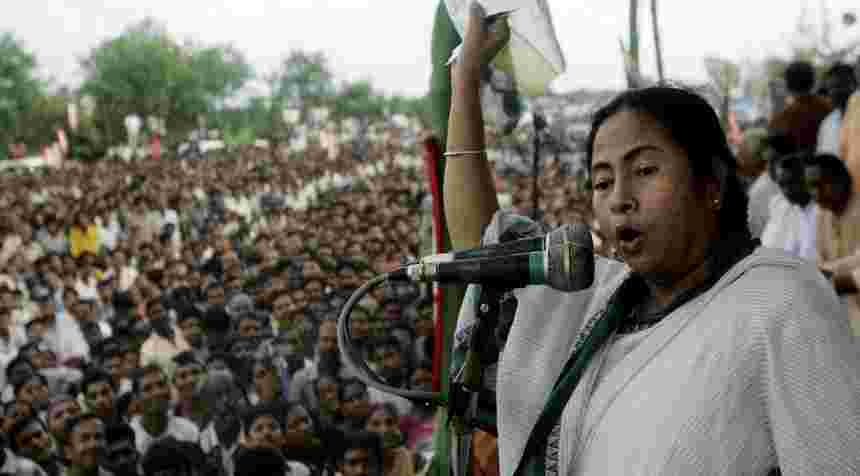
Mamata Banerjee, the chief minister of West Bengal, has taken a swipe at the Centre for prohibiting the sale of cattle for slaughter at the country’s livestock markets, claiming that the policy is unconstitutional. At a news conference at the state secretariat, she declared, “We will not accept the Centre’s decision; it is unlawful, and we will oppose it legally.”She also questioned the timing of the May 23 decision, questioning why it was made so close to Ramadan.
Kerala’s government has criticized the Union government’s action, calling it “fascist.” Other people in his state, according to Chief Minister Pinyari Vijayan, do not require a lesson in dietary habits from New Delhi or Nagpur.

- The video of Bollywood actress Kajol went viral on social media when she was eating beef but she emphasized that she was not eating beef but buffalo meat once the scandal erupted. Kajol was seen in a viral video being offered a meal called ‘beef pepper water with dry lentils and dry beef’ by a man named Ryan Stephen at a party.
Conclusion
- It is to be concluded that many states are having laws for cow slaughter but some states are not having effective laws till now. So, they need to amend the laws.
Top 13 Interesting Facts About Beef Ban
States where cow slaughter is banned: Maharashtra, Haryana, Uttar Pradesh, Tamil Nadu, Rajasthan, Punjab, Odisha, Puducherry, Madhya Pradesh, Karnataka, Jammu & Kashmir, Himachal Pradesh, Gujarat, Delhi, Bihar, and Andhra Pradesh.
Bulls and buffaloes are sold and eaten in most states even where cow slaughter is banned. Karnataka, for example, allows the slaughter of bulls and buffaloes above 12 years.
But some states like Haryana, Rajasthan, Punjab, J&K, and Himachal Pradesh have more stringent laws that ban the slaughter of all.
West Bengal permits the slaughter of cows, bulls, and buffaloes over the age of 14 but requires a ‘fit for slaughter’ certificate.
Daman & Diu and Goa permit the slaughter of those cows which are old or sick, or for medical purposes.
Kerala is believed to be India’s most beef-friendly state. There is no state legislation banning cow slaughter & dishes like ‘beef fry’ and ‘beef chilli’ are available at roadside stalls too.
States like Kerala, Manipur, Mizoram, Meghalaya, Arunachal & Nagaland allow the slaughter of cattle with no certificate required.
Despite the bans, India is only second to Brazil when it comes to exporting beef, but most of it is buffalo meat. It is also the fifth-largest producer.
India’s beef shipments till Oct last year rose to 1.95 million tonnes, 5% more than for the whole of 2013, according to the US department of agriculture.
It is said that over a quarter of India’s population of Scheduled Tribes & Scheduled Castes eat beef. Consumption is also prevalent across all sections of society in states where cow slaughter is legal.
India is the world’s largest beef exporter because the US Department of Agriculture (USDA) categorizes meat of bovine animals like “buffaloes” under “beef”.
While “cow” slaughter is banned in 21 states, there is no such restriction on “buffaloes”.
Meat exported from India is that of water buffaloes hence, there is nothing illegal, immoral or hypocritical in India being the world’s largest beef exporter.





